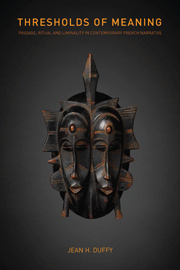Book contents
- Frontmatter
- Contents
- Acknowledgements
- List of illustrations
- Introduction
- 1 At death's door: illness, ritual and liminality in Darrieussecq, Lenoir, and Mauvignier
- 2 Suicide and saving face in Bon, Mauvignier and Bergounioux
- 3 Commemoration, monument and identity in Bergounioux, Darrieussecq and Rouaud
- 4 Retouching the past: family photographs and documents in Rouaud, Bon and Lenoir
- Conclusion: Writing passage and the passage to writing
- Notes
- Select bibliography
- Index
Conclusion: Writing passage and the passage to writing
- Frontmatter
- Contents
- Acknowledgements
- List of illustrations
- Introduction
- 1 At death's door: illness, ritual and liminality in Darrieussecq, Lenoir, and Mauvignier
- 2 Suicide and saving face in Bon, Mauvignier and Bergounioux
- 3 Commemoration, monument and identity in Bergounioux, Darrieussecq and Rouaud
- 4 Retouching the past: family photographs and documents in Rouaud, Bon and Lenoir
- Conclusion: Writing passage and the passage to writing
- Notes
- Select bibliography
- Index
Summary
From its outset, this book set itself a critical agenda that deflected attention away from the reflexive and metafictional aspects of the selected texts in favour of a reading that would highlight their thematic range and density and provide some measure of the complexity of their engagement with the ‘real’ and with the social, religious and cultural structures by which man tries to make sense of reality. Foremost on this agenda and central to the inquiry conducted in the intervening pages have been the following priorities: the provision of a selective survey of late twentiethand early twenty-first century fiction and autofiction highlighting the thematic, as opposed to purely formal, continuity linking contemporary French narrative with its ancestors of the 1960s and 1970s; the demonstration of the recurrence across the corpus of a thematic pattern relating to ritual, passage and liminality; the exploration of this pattern through a series of close readings which, while drawing upon ritual theory for their broad framework, would be responsive to the inflections and nuances of each text; and, finally, the identification of some of the thematic preoccupations and formal features that appear to give the constantly growing body of each writer's œuvre its distinctive authorial stamp.
- Type
- Chapter
- Information
- Thresholds of MeaningPassage, Ritual and Liminality in Contemporary French Narrative, pp. 259 - 301Publisher: Liverpool University PressPrint publication year: 2011

